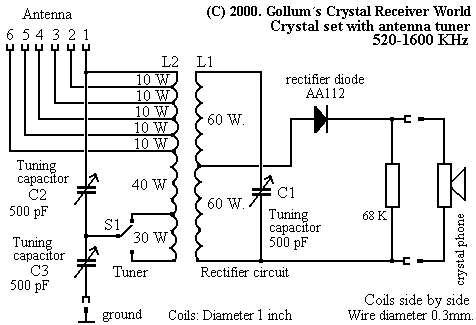Crystal receiver with antenna tuner
Construction project
Detektor-Empfaenger mit Antennen-Anpasser
Bau-Vorschlag

Antenna tuner: Employing an antenna tuner/matcher offers better results. It is true that you will need additional components. My circuit needs two additional variable capacitors and one switch. There are different construction projects (also in the Internet). Not always they take into account that it is difficult to cover the whole tuning range with different antennas. Especially circuits using two variable capacitors (C2 und C3) on one shaft may suffer from tracking problems. My circuit avoids capacitors on a single shaft.
Coils: (cylinder coils) Coupling of the tuning circuits is inductive. Coils L1 and L2 are wound on two seperate coil formers next to another with spacing of 3 mm between them (not in line). Use solid copper wire or better r.f. litz wire. More information about litz wire you will find here. As coil former you can use card board pipe or plastic (e.g. PVC) pipe.
Switch: Switch S1 changes the tuning range of the tuner. This guaranties that the whole tuning range of the bc band (520-1620 KHz in Europe) is covered.
Antenna connections: Sockets 1-6 are used to find the best connection for the antenna. My circuit was checked with antenna lenghts of 30 to 100 feet. May be that you must connect the antenna plug to another socket when tuning towards to band ends. When you prefer you can connect coil taps 1-6 to a six position rotary switch and use only one antenna socket.
Variable capacitors: C1 tunes to frequency. C2 and C3 tune mutually to maximum reception, first C2 and then C3. Repeat as required. When you arrive at either minimum or maximum capacity without achieving maximum reception, plug the antenna to next jack. You will need some practice in tuning to achieve optimal reception. You will be rewarded with best slectivity and good volume.
(Thanks to my friend Peter Stepponat for translation.)
Antennen-Tuner: Mit einem Antennen- Anpasser (Tuner / Matcher) gelingt eine bessere Anpassung. Allerdings ist der Abstimm-Aufwand groesser. Meine Schaltung benoetigt zusaetzlich 2 Drehkondensatoeren und 1 Schalter. Es gibt verschiedene Bauvorschlaege (auch im Internet). Nicht immer wird dabei bedacht, dass es schwierig wird, den gesamten Frequenzbereich mit verschiedenen Antennen voll einstellen zu koennen. Insbesondere bei Schaltungen mit 2 Drehkondensatoren (C2 und C3) auf einer gemeinsamen Achse koennen Gleichlauf-Probleme auftreten. Meine Schaltung nutzt keine Drehkondensatoren auf einer gemeinsamen Achse.
Spulen: (Zylinderspulen) Die Kopplung der beiden Schwingkreise erfolgt bei dem unten gezeigten Schaltbild induktiv. Die beiden Spulen L1 und L2 werden im Abstand von 3 mm nebeneinander aufgebaut (nicht auf einer Achse). Verwenden Sie Kupfer-Volldraht oder besser HF-Litze. Mehr Informationen ueber Litze finden Sie hier. Als Spulenkoerper koennen Sie ein Papp- oder Plastik (z.B. PVC) Rohr vwerwenden.
Schalter: Schalter 1 aendert den Frequenzbereich des Antennen-Tuner-Kreises. Es wird so sichergestellt, dass der gesamte MW-Bereich (520-1620 KHz) abgestimmt werden kann.
Antennanschluesse: Die Buchsen 1-6 werden benutzt, um den besten Anschluss fuer die Antenne zu finden. Meine Schaltung wurde mit Antennen-Laengen von 10-30 Meter getestet. Es kann sein, dass sie umstecken muessen, wenn Sie die Frequenz zu den Band-Enden verstellen.Wenn Sie wollen, koennen Sie die Buchsen 1-6 ueber einen 6-fach Umschalter fuehren und dann nur eine Antennen-Buchse anwenden.
Drehkondensatoren: C1 stellt die gewuenschte Frequenz ein. C2 und C3 werden wechselseitig auf Empfangs-Maximum eingestellt, zuerst C2, dann C3. Eventuell wiederholen. Erreichen Sie den Anschlag dieser Kondensatoren ohne dass ein Maximum auftritt, ist die Antenne umzustecken. Sie brauchen eine gewisse Uebung, um die Einstellung optimal vornehmen zu koennen. Belohnung ist eine optimale Selektion bei guter Lautstaerke.